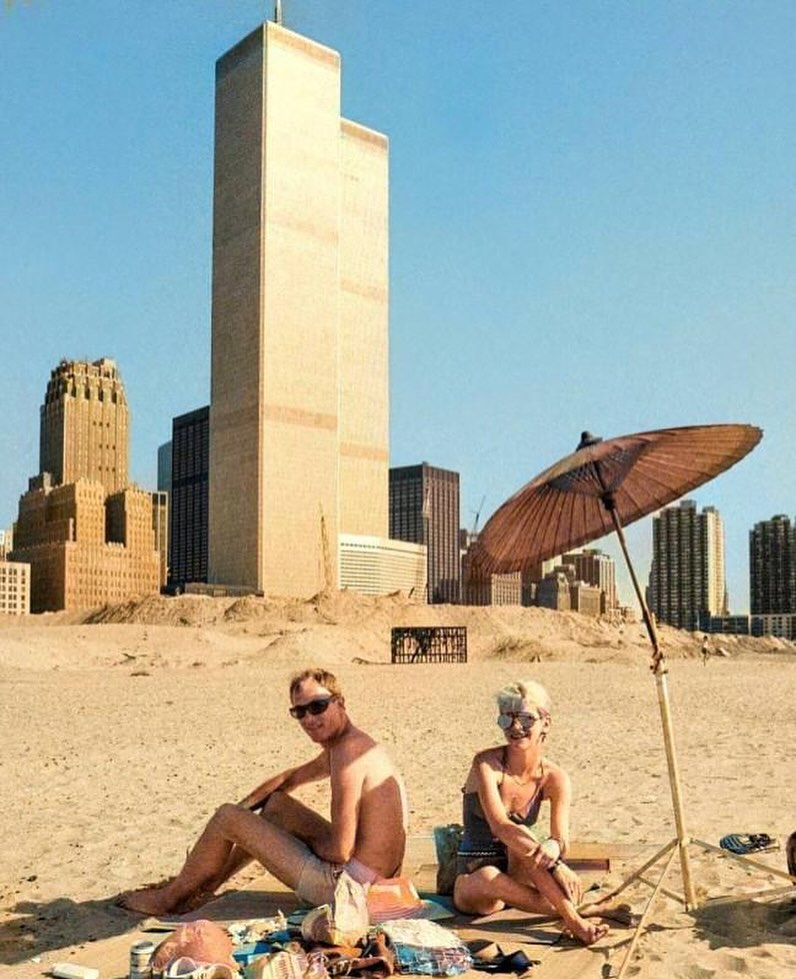
New York City, the bustling metropolis we all know today, is a place of constant change. But did you know that in the 1970s, just steps away from the iconic Twin Towers, there existed a beach that was once a secret haven for city dwellers? Battery Park Beach, a forgotten gem of Manhattan, was a place where sunbathers, activists, and artists came together. In this article, we’ll take a trip back in time to explore the history of this lost beach and its impact on New York’s culture.
How Did Battery Park Beach Come to Life?
A Strange Beginning: Construction Turns into a Beach
The story of Battery Park Beach starts with the construction of the World Trade Center. In the early 1970s, massive excavation work was carried out to lay the foundations of the towers. This resulted in a temporary strip of sand along the waterfront, which was never intended to be a public beach. But as with many things in New York, the people took it over and made it their own.
New Yorkers Embrace the Unexpected Oasis
Though the sand wasn’t exactly the soft tropical kind you might imagine, it became a beloved retreat for Manhattanites looking for a quick escape from city life. Locals started lounging, sunbathing, playing volleyball, and even enjoying a bit of solitude—all with the majestic Twin Towers standing tall in the background.
The Beach Becomes a Cultural Hub
A Gathering Place for Activism and Expression
Battery Park Beach wasn’t just a place for relaxation. In 1979, it hosted the largest anti-nuclear rally in U.S. history. Around 200,000 people gathered on the beach, rallying for peace and environmental awareness. Celebrities like Pete Seeger and Jane Fonda were on hand, adding a touch of star power to this massive event. It was a defining moment for activism in the post-Vietnam War era.
An Artistic Playground for Public Art
In addition to activism, the beach became a hub for creative expression. The Creative Time organization, known for bringing public art to unexpected places, turned Battery Park Beach into a canvas for innovative art installations. Artists like Nancy Rubins and Agnes Denes used the space to make powerful statements about the environment, urbanization, and the world we live in.
The Decline of Battery Park Beach
The Development of Battery Park City
As the years passed, Manhattan began to change. In the 1980s, Battery Park City started to take shape, and construction overtook the once-popular beach. By the early 2000s, most of the sandy area had been replaced by development, and Battery Park Beach slowly faded into memory.
The Shadow of 9/11 and the Loss of an Era
The tragic events of September 11, 2001, forever altered the landscape of Lower Manhattan, and with it, the memories of Battery Park Beach. The Twin Towers, once the backdrop to peaceful moments on the sand, were no more. The beach, like many other pieces of New York’s past, became a distant memory, tinged with sadness and reflection.
The Legacy of Battery Park Beach
A Symbol of Change and Resilience
Even though the beach is long gone, its legacy lives on. For those who spent their weekends basking in the sun there, Battery Park Beach was more than just a spot for relaxation—it was a place of cultural significance. It was a gathering space, a protest ground, and a canvas for artists. Its short-lived existence serves as a poignant reminder of how quickly things can change in a city like New York.
Why We Remember Battery Park Beach
While it’s easy to forget small pockets of history in the hustle and bustle of modern life, places like Battery Park Beach remind us of a time when New Yorkers found moments of peace in unexpected places. The photos from that era, showing people lounging under the Twin Towers, capture more than just a moment of leisure. They symbolize the fragility of life and how memories can endure long after the physical space has disappeared.
Conclusion: The Beach That Once Was
In a city that’s constantly evolving, the lost beach near the Twin Towers is a reminder that New York’s history is filled with hidden gems. Battery Park Beach, though short-lived, played a unique role in the cultural fabric of the city. It was a place of relaxation, protest, and creativity, all under the towering shadows of the Twin Towers. Today, as we reflect on its memory, we are reminded that sometimes the most unexpected places hold the most profound stories.
Let this story be a testament to how New York, like its people, is always changing—adapting, growing, and leaving behind pieces of its past that are worth remembering.





